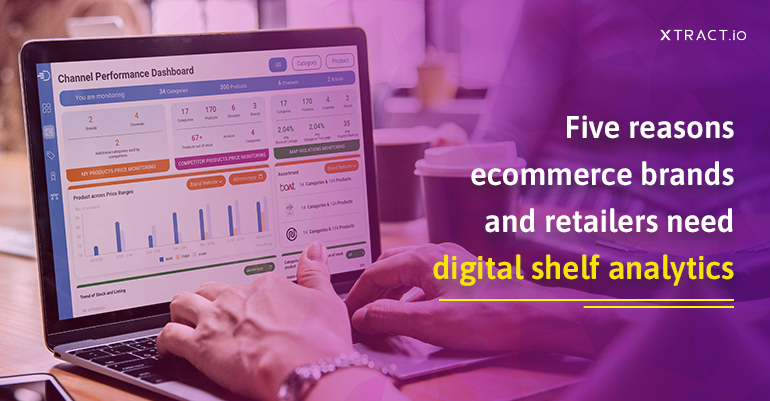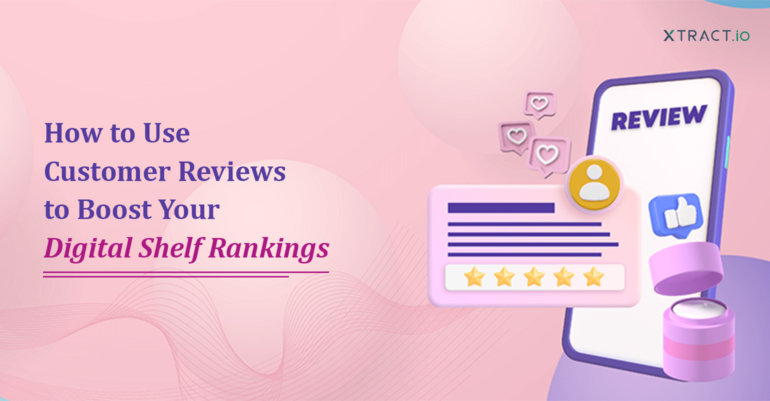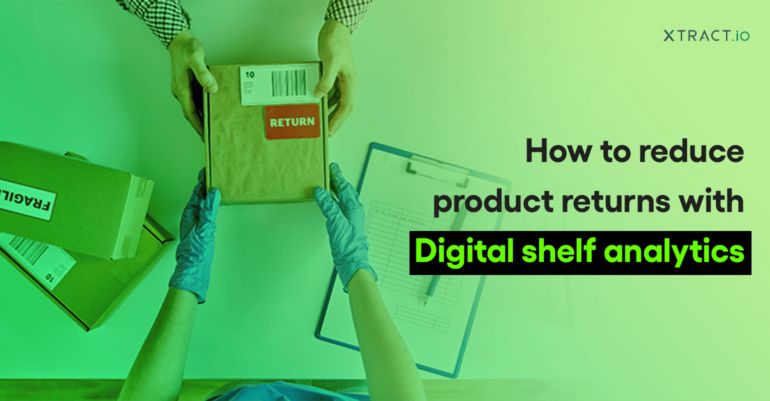Digital shelf analytics is as crucial for ecommerce as SATs for college. Can you imagine attending school or college without ever knowing your academic performance? Of course not. It is almost impossible for any business to grow without having a complete view of its performance and foresight into its growth. And that is precisely what digital shelf analytics brings to the table.
Ecommerce businesses must analyze their online performance vigorously to capacitate themselves with the right decisions and actions. Without a complete view of your online business performance, learning which strategies work well for your digital shelf and those that don’t is challenging.
On the other hand, if you have a comprehensive view of your digital shelf, it is easier to know the areas in your business that are on track and the areas that could use a little improvement. That being said, it is highly recommended that one completely understands what a digital shelf is and how a digital shelf analytics tool can be your ticket to success.
Let’s dive right in!
What is a digital shelf?
A digital shelf is like any physical store where you can browse, select, and pay to purchase products, but only online. Customers can search, check, and compare products online before purchasing. Unlike brick-and-mortar stores, the only catch is that one cannot touch or feel the product.
And that is one of the significant challenges online brands and retailers face while selling products. But digital shelf analytics makes it seamless for ecommerce businesses to optimize their online store in a way that eases the customer shopping experience.
For example, displaying detailed and accurate product information, including product descriptions, attributes, images, or videos. Adding these data to your digital shelf can improve customer trust in your brand or retail store and accelerate purchasing decisions. However, brands must frequently monitor their digital shelf to ensure that ecommerce websites or product catalogs are up-to-date and display complete product information.
And that’s where digital shelf analytics proves useful. Although, this is just one of the essential aspects digital shelf analytics can help you with. We will dive deeper into the areas where digital shelf analytics can help ecommerce businesses perform better.
Why is digital shelf monitoring important for brands and retailers?
A global digital shelf market report states that the market size will grow from $0.38 billion in 2021 to $7.4 billion by 2030 at a CAGR of 40.1%. The drastic growth indicates that more and more online brands and retailers are adopting digital shelf analytics to drive sales.
Digital shelf monitoring can solve many challenges surrounding your online business. From insights into your products’ performance to ensuring stock availability, digital shelf analytics can take the load off your shoulders. Let’s look at how you can use the platform for digital shelf optimization.
1. Helps optimize product listings
Digital shelf monitoring enables brands and retailers to keep track of their product listings and ensure that they are accurate, up-to-date, and complete. Brands that do not track and measure the performance of their product listings might fail to attract shoppers and lose out on potential customers.
This, in turn, directly impacts sales as shoppers tend to buy from brands or websites that offer complete product details for them to compare products.
2. Keeps you updated on competitor moves
Whether you are entering a new market or have been in the ecommerce game for decades, you cannot ignore what your competitors are doing. Tracking competitor moves does not necessarily mean that you have to mirror them. Brands and retailers can learn from their competitors’ strategies and develop a more powerful plan of action to outsmart them.
Digital shelf analytics allows you to keep an eye on competitors’ product listings, prices, promotions, and other marketing activities. This lets you stay competitive in the market and make informed decisions about your pricing and promotions.
3. Improves customer experience
According to Gartner, customer experience is the top priority for businesses, with 80% of companies saying they plan to compete mainly based on customer experience. You will lose customers big time if your online store is not up to par.
In this digital age, shoppers are only willing to conduct business with brands that prioritize their needs and preferences. And the quality of your product catalogs or listings can influence their purchasing decisions.
Moreover, with digital shelf monitoring, brands, and retailers can identify and resolve issues with their product listings, such as incorrect product descriptions or images. This helps to improve the overall customer experience, reduce the likelihood of negative reviews or returns, and boost loyalty.
4. Enhances supply chain management
Nothing is more frustrating for a shopper than finding the product they want to buy is “out of stock.” The shopper will buy from a different brand or website, but you would lose on a potential customer who could have easily been a repeat customer.
Therefore, we cannot stress enough that monitoring inventory levels, detecting out-of-stock products, and identifying supply chain issues in real-time is pivotal for running a successful business. Also, it ensures that products are always available to customers and that the supply chain functions smoothly.
5. Drives sales and revenue growth
The ultimate goal for every business is to maximize its sales and profits. If you can offer your customers best-in-class shopping experiences, then the success of your ecommerce business is guaranteed.
Brands and retailers can optimize product listings, optimally price their products, and build result-driven strategies with digital shelf analytics. Standing out amongst your competitors will get your online business the attention it deserves, leading to an increase in sales.
Overall, digital shelf monitoring is essential for brands and retailers to stay competitive in the rapidly evolving e-commerce landscape and improve the customer experience. By leveraging data and insights, brands and retailers can optimize their online presence, drive sales, and enhance customer loyalty.
Finding the right fit
All being said, finding a digital shelf analytics platform that covers all your digital shelf needs can be daunting. We have included some factors you should consider when choosing a digital shelf analytics platform to make the process easier.
- Data accuracy and coverage: The platform should provide accurate and comprehensive data on product listings, pricing, promotions, and other relevant information across multiple retailers and e-commerce channels.
- Real-time monitoring: The platform should enable real-time monitoring of digital shelf data for you to detect and respond to market changes and stay ahead quickly.
- Customization, flexibility, and scalability: The platform should offer customization and flexibility to meet your unique needs and requirements, including customizable dashboards, reports, and alerts.
- Actionable insights: The platform should provide accurate insights and recommendations to help optimize your online presence and improve the customer experience.
- User-friendly interface: The digital shelf analytics platform should have a user-friendly interface that is easy to navigate and understand, even for non-technical users.
- Customer support: The platform should offer reliable and responsive customer support, including training and ongoing support, to help you get the most out of the platform.
Considering these factors, you can identify the digital shelf analytics platform that best meets your needs and helps you achieve your goals.
Introducing DigiSense360 – A powerful digital shelf analytics platform
Built for brands and retailers of all sizes, the platform offers ecommerce intelligence by letting you access your and competitors’ products’ performance and overall market view. You can use these valuable insights to improve your performance and grow your business.
1. Product performance
You can track and monitor your digital shelf performance down to category and product level across multiple sales channels. Additionally, you can get insights into product offering gaps to optimize your catalogs and include additional products to maximize sales.
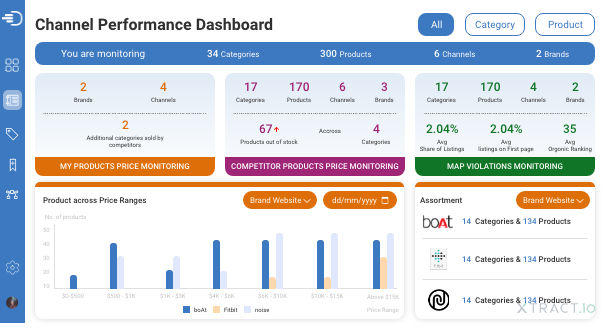
2. Competitor analysis
The platform allows you to analyze competitors’ products, pricing, and promotional strategies. The ecommerce intelligence platform offers a unified view of real-time and historical data to understand competitor and market trends. Additionally, you can monitor MAP violations and take instant action to protect your reputation.

3. Inventory management
It makes managing product availability a breeze. You can monitor inventory levels and identify products that are out of stock or running low. You can make more informed decisions about restocking and pricing by tracking product availability.
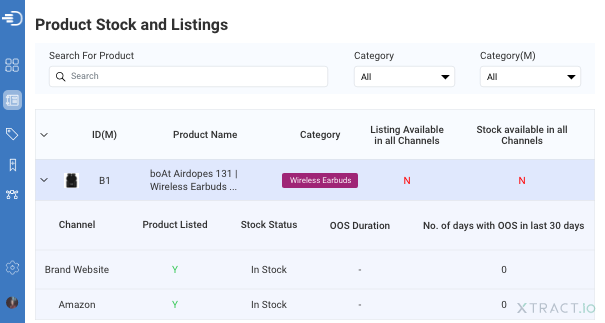
4. Pricing optimization
You can use digital shelf analytics to optimize your pricing strategies by analyzing the pricing data of unlimited market players. It will further help identify opportunities to increase revenue and improve profit margins.
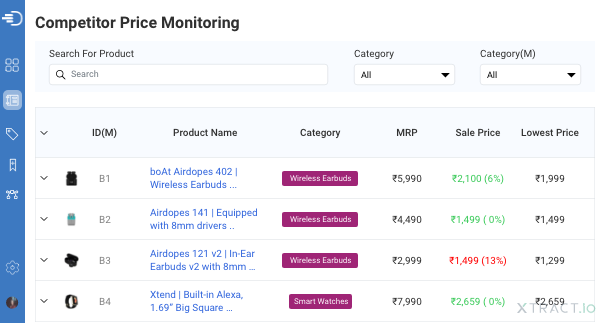
5. Product listing optimization
This brilliant feature lets you improve organic search ranking through regular content audits and helps you optimize your listings with the right target keywords to strengthen your SEO game. These audits also prove helpful in complying with the unique guidelines of different marketplaces.
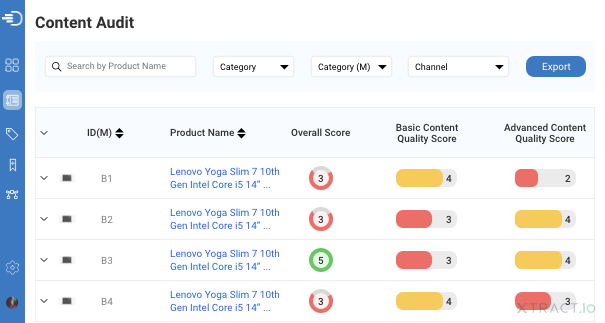
6. Ratings and reviews management
You can keep an eye on customer reviews and feedback on multiple channels and take appropriate actions instantly to build customer trust. The platform comes with sentiment analysis and reviews classification capabilities to help gauge customer sentiment toward your products and brand.

The digital shelf analytics platform can address all your ecommerce requirements with its customizable and scalable features. Gain insights into your business’ performance and manage and measure your KPIs with the most advanced platform in the market. Sign up for a free demo today and connect with our ecommerce experts for a quick walk-through.


